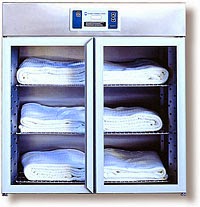There are a number of reasons that surgical delivery may be the safest route for mom and baby. Most moms do not get to plan their first C-section, but find that conditions that are out of her control make it necessary. Cesarean Section delivery is offered to patients for various reasons. Whether it is a scheduled repeat Cesarean Section or recommended for mom's and baby's well-being we are here to help!
All of our nurses are specially trained through the Association of Peri-Operative Registered Nurses (AORN) to provide the safest operating room care available. This allows your labor nurse to follow you through the delivery process regardless of the delivery route. It is comforting to know and trust your chosen provider, as well as, the nurse primarily responsible for your care.
If an emergency were to arise we have OB-certified Laborists who are in the hospital 24 hours every day. They are skilled and available to begin surgery until your chosen provider arrives and can assume care. Our anesthesia department also provides 24 hour immediate coverage.
As part of our Labor & Delivery team, we have a Certified Surgical Technician who works specifically on our unit, ready and available if needed, all the time.
Operating rooms are closed to the public to keep the environment as sterile as possible for the safety of our patients.
Because of the unique situation of the delivery of a baby occurring in our operating rooms, we allow one guest to join us in the O.R. The only time this would not occur is if there was a need for general anesthesia. If our patient needs to go to sleep for any reason, our undivided attention must be on the situation and outside guests are asked to wait just outside the O.R.
Guests who do join us must change out of their own clothing and into hospital scrubs. In addition, they are required to wear the protective hats, masks and shoe covers, just as the medical team, to keep a sterile environment and patient safety our top priority.
Our guest waits just outside the O.R suites while we get ready for surgery. We will come and get you just before surgery begins. This can seem like a long wait, but we are working as quickly as possible to ensure everyone and everything are exactly as they need to be!
We have 3 operating rooms located on our Labor and Delivery unit. They are always ready for any urgent need.
Still photographs are welcome and encouraged in our operating rooms to capture those irreplaceable delivery photos. Video in the O.R. is against hospital policy and therefore not allowed.
We do have CD players in our operating rooms. As in any delivery on our unit, the patient can request or provide music to be played during delivery.
A member of our anesthesia team will be supporting you the entire surgery. They will stay with you and your support person at the head of the bed to assist with any needs, questions, or concerns while in the operating room.
Once the baby is delivered, the NICU team waits at the warmer, just to the patient's left, to assess the baby. If mom and baby are both stable, we encourage skin to skin bonding while in the operating room. The NICU nurse coordinates with anesthesia to make this happen. We like to keep our moms and babies together as much as possible.
Once surgery is complete, our patients are moved to one of our Post-Operative recovery rooms. We have 2 located on our Labor and Delivery unit. These rooms are equipped specifically for patients who are recovering from surgical anesthesia. We anticipate that this recovery will last for the next 2 hours. During this time, one of our Newborn Nursery nurse experts will visit to provide education, breastfeeding support and follow up assessments as needed.
Because the level of assessment care is higher during this initial recovery period, we allow additional visitors to come and meet the new arrival at this time. However, we ask that visitors be limited to 2 at a time in order for our staff to provide the exceptional care expected while at St. Luke's.
After this recovery period, patients are transferred to our Mother Baby Unit. Continued level of higher nursing assessment is maintained post surgery, and although length of stay is anticipated to be a little longer than a vaginal delivery (typically 72 hours), the learning and bonding with this new baby is not different.
Finally 10 helpful insights about Cesarean Sections that might be helpful to know:

#1 This is YOUR birth story. You just had a baby. If you have a C-section don't allow anyone else influence your experience by convincing you that a surgical delivery is any less of a birth experience. That is not true. What is true is that C-sections are major abdominal surgery and that the recovery takes a little longer. There are more risks associated with surgical deliveries which is why we prefer to attempt vaginal delivery whenever possible. However, the outcome is the same - a new baby has been delivered and the joys and pains of parenthood do not diminish based on route of delivery.
#2 Take Advantage of the TIME - the first day will be spent mostly in bed. After anesthesia you will not have the strength or control to stand or walk for the first few hours. Because of this you will have a Foley catheter placed to help drain your bladder. You will have compression devices on your legs to assist with circulation which will help prevent blood clots. IV access will be maintained until you are able to get up and care for yourself. The first few times you are out of bed we want to be there to assist you and make sure that you do not fall.

Do not think of this as being "stuck" but enjoy this time to catch up on the sleep you have missed (and will miss in the future) and to bond with your baby. Take time to practice and receive expert help with breastfeeding. Enjoy the leg massage from the compression devices and the fact that you no longer have to get up every couple of hours to empty your bladder. Sometimes we forget to look at the positive aspects of this TIME!
#3. Right after delivery you may feel itchy or uncontrollably shake. This can be very normal. One possible side effect of anesthesia is itching. If the itching is more than you can tolerate, or lasts longer than a few hours tell your nurse - there are things that we can do, or medication we can give for this. Try not to scratch. When you are numb you don't always realize how hard you are scratching and this can be very painful as anesthesia wears off. Another thing you may notice is shaking. This can also be a normal side effect of your body's hormone shift as well as anesthesia. The more you try to stop shaking the harder you will seem to shake. RELAX. Warm blankets may be comforting.
#4 Speaking of warm blankets - BE COMFORTABLE - most patients after any delivery feel cold. Warm blankets and ice chips seem to be everyone's favorite things! If your blankets are not warm - ask - we have plenty!

#5 SHOULDER PAIN. Referred nerve pain from the abdominal muscles may present as shoulder pain (your shoulder is not numb but your abdominal nerves still are) or it may be caused by air trapped after the incision was closed. Either way, shoulder pain can be uncomfortable. Initially we will treat this with heat or ice packs. If it continues, we can give medication to help with the nerve and/or gas pain until it subsides. Please let us know!!
#6 Breastfeeding. Regardless of method of delivery we encourage all moms to initiate breastfeeding within the first hour after delivery whenever possible. Positioning to breastfeed initially after a C-section takes a little more patience. Things to consider are that it will be more difficult to sit all the way up, and as anesthesia begins to decrease, sensation in the incision area increases. Our nurses will assist you with position options, and help to figure out what positions work best for your situation.
#7 EATING. Go SLOW - before surgery it is most likely that you will not have eaten anything solid for quite a few hours. You will be hungry. Your stomach is still waking up so start with ice chips. If you are able to eat them without feeling nauseated then move to sips of water. Many patients advance their diet too quickly and end up vomiting. This can be extremely uncomfortable after abdominal surgery. I promise you will eat again, but be patient and take it slowly!

#8 Pain Medication. Stay on top of the pain. Although we do not encourage you to take more medication than necessary, we do suggest that you take your medication as prescribed. Cesarean Section surgery is not pain free. If you manage your pain appropriately, you will still experience some discomfort, but you will heal faster and be able to provide care for yourself and your baby. Take pain medication when you need it and document the time so that you remember how often you have taken it and how much you needed. This will help your provider to manage your pain levels and assist you as you are preparing to discharge home.

#9. Once a C-section NOT always a C-section. There was a time when having a Cesarean delivery for any reason meant that you would be counselled that Cesarean Delivery would be the safest method of delivery for every pregnancy going forward. This is not the case any longer. Vaginal Birth After Cesarean (VBAC) definitely comes with risks but is more commonly practiced and accepted. Discuss the reasons for the previous Cesarean section with your provider and understand the risks and benefits associated with attempting a VBAC. Facilities that have 24 hour immediate O.R. access typically offer this as an option.
#10. ACCEPT HELP! When you are discharged home accept help from family and friends. If no help is offered, ASK. During your recovery you will be advised not to lift anything heavy, take the stairs, or even vacuum. Simple things like coughing or turning can cause discomfort. Over doing it during recovery can prolong your recovery and possibly cause avoidable complications. While you are hospitalized take advantage of room service dining and the staff who are there to assist you. When you are home, think ahead and have someone help you to position pillows, prepare meals, organize diapers, bottles, etc so that you have easy access to whatever you may need if you are alone.


































































